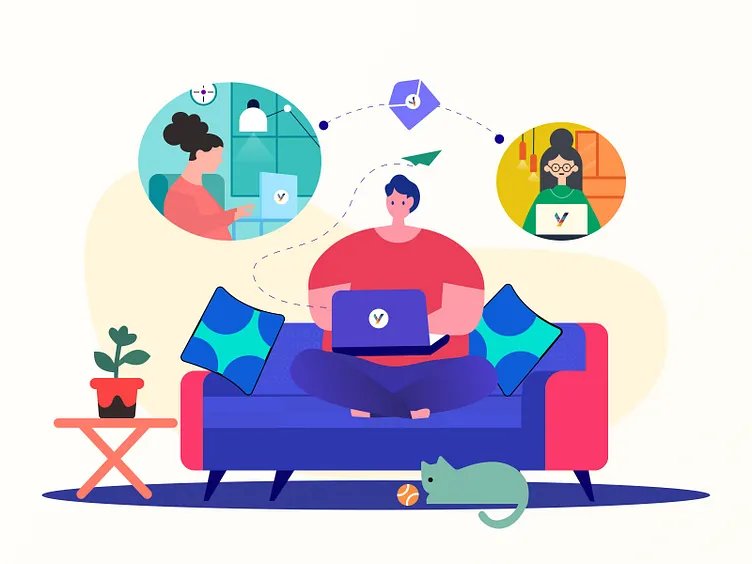Remote work blossomed over the last decade into the new normal rather than the exception. What companies initially adopted for health reasons settled into everyday practice—largely because it worked. Entire cultures and processes that once required physical closeness learned to thrive across screens. Cloud tools, video calls, and collaborative software became as standard as the water cooler, breaking the old office-only mindset and widening the future of work to any spot with good Wi-Fi.
The Growing Popularity of Remote Work

Working from wherever you choose isn’t a fad; it’s a worldwide shift that’s settled in for the long haul. Surveys show that more than a third of American workers are logging in from outside the office today, and that figure keeps climbing. Employers are discovering that happier employees lead to better output and that overall expenses drop when you lessen the office footprint. As organizations welcome the change, team members are enjoying the breathing room to juggle zooms and deadlines alongside family, hobbies, and life.
Why Remote Work is Here to Stay

- Increased Work-Life Balance
Remote work’s biggest draw is how it lets people integrate their personal lives with their jobs. Ditching the commute frees up hours that can be spent with family, picking up a hobby, or just resting. That added flexibility lets everyone juggle work duties and life’s demands with less friction, which usually means a more satisfied and engaged team overall.
-
Cost Savings for Employers and Employees
Having most employees working from home lowers the overall costs that companies have to run on daily. Without the need to keep the lights on and the HVAC running for a full office, and without the space for rows of empty desks, firms find the expense of rent and utilities drops quickly. Meanwhile, workers see the upside, pocketing the money they no longer spend on gas, train passes, lunch runs, and that dry cleaner bill for blazers they’ve rarely put on. Both sides end up in the black on the budget sheet.
Key Benefits of Remote Work

-
Global Talent Pool
The rise of remote work has transformed the hiring landscape for everyone involved. Employers can now build teams that include the best specialists regardless of where they live; they are no longer confined by local talent pools. This makes it easier to find precisely the right skills, and it often leads to more diverse, innovative teams. For employees, the same shift means that attractive positions no longer require relocation. People can now compete for roles in prestigious companies without the cost and disruption of moving. This symmetry of options makes the job market more dynamic and richer for both sides.
-
Improved Productivity and Focus
When you trade the cubicle for the home office, those little disruptions that used to steal your attention tend to vanish. Without the constant buzz of hallway chatter, unexpected drop-by conversations, or the hum of shared printers, it’s far easier to settle into deep work. Surveys of remote teams consistently show that the ability to control interruptions boosts overall output. On top of that, being able to tweak the lighting, temperature, or even soundtrack to suit your personal preferences gives most people a lift. Those same people often say they feel happier in their roles because they’ve gained autonomy over where and how the work get done.
-
Environmental Impact
The decline in commuting frequencies associated with widespread remote work arrangements generates measurable environmental gains. Reduced vehicular traffic directly correlates with diminished greenhouse gas release and suspended particulate matter, thus enhancing air quality and lowering organizational and personal ecological footprints. Sustained sector-wide embrace of telecommuting is likely to amplify these favorable ecological outcomes over time.
The Challenges of Remote Work

Although the advantages of remote work are well documented, its implementation presents a range of difficulties. Employees may encounter feelings of isolation, reduced interpersonally derived motivation, and complications in delineating professional duties from domestic environments. To mitigate these drawbacks, organizations are increasingly integrating structured virtual gatherings, orchestrating informal team-building pursuits, and establishing explicit temporal and spatial boundaries that differentiate work obligations from personal life.
Tips for Success in Remote Work

-
Create a Dedicated Workspace
Establishing a designated workspace is a critical factor in sustaining concentrated attention and in creating a boundary between occupational duties and private life. The area need not be expansive; it may consist of a tranquil niche or an entire room. The key is to ensure that the environment is ergonomically supportive and devoid of external disruptions.
-
Set Clear Boundaries
When operating from home, the separation between professional and private life can quickly dissolve. To counteract this risk, establish explicit work hours and share this schedule with household members and close social contacts. Such transparency reinforces the boundary between labor and leisure, thereby preserving the integrity of both domains and protecting against the risk of professional overcommitment.
-
Use Technology to Stay Connected
Utilize video conferencing applications, instant messaging software, and collaborative digital platforms to maintain ongoing engagement with both colleagues and clients. Such technologies provide seamless connectivity, ensuring that information flow remains uninterrupted and that effective dialogue continues. For geographically distributed teams, consistent and transparent communication is essential to sustaining productivity and fostering organizational cohesion.
The Future of Remote Work: What to Expect
The trajectory of remote work appears both bright and stable as ongoing technological progress continually refines real-time communication, collaborative interfaces, and workflow orchestration platforms. The widespread deployment of 5G networks, together with increasingly sophisticated AI-driven applications, will raise the effectiveness and ease of remote participation to new levels. Concurrently, organisations are expected to formally institutionalise hybrid employment architectures, permitting workers to choose the site—remote or in-office—most conducive to the specific cognitive and social demands of a given assignment.








